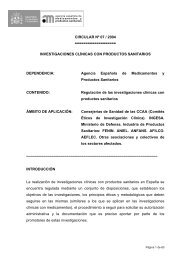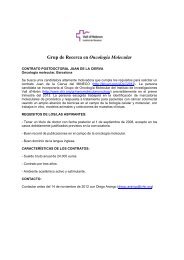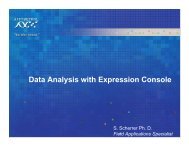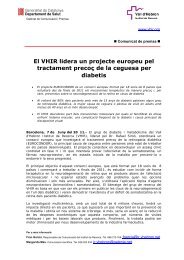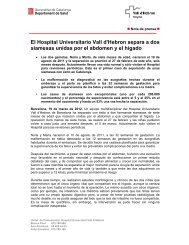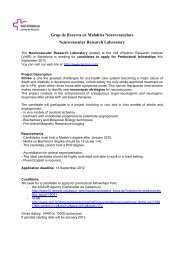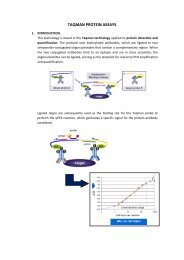TechNotes 11(1) Assessing RNA Quality - VHIR
TechNotes 11(1) Assessing RNA Quality - VHIR
TechNotes 11(1) Assessing RNA Quality - VHIR
Create successful ePaper yourself
Turn your PDF publications into a flip-book with our unique Google optimized e-Paper software.
Ambion <strong>TechNotes</strong> <strong>11</strong>(1): <strong>Assessing</strong> <strong>RNA</strong> <strong>Quality</strong><br />
http://www.ambion.com/techlib/tn/<strong>11</strong>1/8.html<br />
Página 1 de 6<br />
16/09/2005<br />
Shop | My Account | View Cart<br />
nmlkji Products<br />
nmlkj Documents<br />
Technical Resources > Reading Room > <strong>TechNotes</strong> > Volume <strong>11</strong>:1<br />
<strong>TechNotes</strong> <strong>11</strong>(1)<br />
<strong>Assessing</strong> <strong>RNA</strong> <strong>Quality</strong><br />
<strong>TechNotes</strong> Archive<br />
Melanie Palmer and Ellen Prediger<br />
This is the first in a series of columns on <strong>RNA</strong> quality and <strong>RNA</strong> sample assessment.<br />
Watch for future articles on this subject in upcoming <strong>TechNotes</strong> issues.<br />
m<strong>RNA</strong> Integrity<br />
Because m<strong>RNA</strong> comprises only 1-3% of total <strong>RNA</strong> samples it is not readily<br />
detectable even with the most sensitive of methods. Ribosomal <strong>RNA</strong>, on the<br />
other hand, makes up >80% of total <strong>RNA</strong> samples, with the majority of that<br />
comprised by the 28S and 18S r<strong>RNA</strong> species (in mammalian systems). m<strong>RNA</strong><br />
quality has historically been assessed by electrophoresis of total <strong>RNA</strong><br />
followed by staining with ethidium bromide (see Denaturing gel<br />
electrophoresis at right). This method relies on the assumption that r<strong>RNA</strong><br />
quality and quantity reflect that of the underlying m<strong>RNA</strong> population. Because<br />
mammalian 28S and 18S r<strong>RNA</strong>s are approximately 5 kb and 2 kb in size, the<br />
theoretical 28S:18S ratio is approximately 2.7:1; but a 2:1 ratio has long<br />
been considered the benchmark for intact <strong>RNA</strong>. While crisp 28S and 18S<br />
r<strong>RNA</strong> bands are indicative of intact <strong>RNA</strong>, it is less clear how these long-lived<br />
and abundant molecules actually reflect the quality of the underlying m<strong>RNA</strong><br />
population, which turns over much more rapidly.<br />
Visual assessment of the 28S:18S r<strong>RNA</strong> ratio on agarose gels is somewhat<br />
subjective because appearance of r<strong>RNA</strong> bands is affected by electrophoresis<br />
conditions, amount of <strong>RNA</strong> loaded, and saturation of ethidium bromide<br />
fluorescence (Figure 1). An improved analytical tool for total <strong>RNA</strong> analysis is<br />
the Agilent 2100 bioanalyzer, which uses a combination of microfluidics,<br />
capillary electrophoresis, and fluorescence to evaluate both <strong>RNA</strong><br />
concentration and integrity (see Agilent 2100 bioanalyzer, right, and<br />
www.ambion.com/prod/<strong>RNA</strong>6000 for more details about this analysis<br />
tool). Another advantage is that it requires very small inputs, allowing the<br />
user to assay <strong>RNA</strong> quality in limiting samples. At Ambion, we use this tool to<br />
assess the quality of our pre-made <strong>RNA</strong>s. We have also used it to examine<br />
the relationship between total <strong>RNA</strong> profiles and the integrity of m<strong>RNA</strong>. Some<br />
of our results are discussed in the following sections.<br />
Related Links:<br />
Effect of Freeze-Thawing of Tissue<br />
on <strong>RNA</strong> Integrity<br />
[read]<br />
Make Time Stand Still with<br />
<strong>RNA</strong>later<br />
[read]<br />
Thaw Frozen Tissues without<br />
Damaging <strong>RNA</strong><br />
[read]<br />
Denaturing gel<br />
electrophoresis. Denaturing<br />
agarose gel systems include either<br />
formaldehyde and MOPs buffer, or<br />
glyoxal in the loading buffer, to<br />
denature the <strong>RNA</strong> so that molecules<br />
will run by size. The 28S and 18S<br />
r<strong>RNA</strong> bands are visualized by<br />
ethidium bromide staining. It is<br />
typically necessary to load at least 1<br />
µg of total <strong>RNA</strong> to visualize the r<strong>RNA</strong><br />
bands clearly with EtBr. More<br />
sensitive dyes such as RiboGreen®<br />
allow one to start with about 10X<br />
less total <strong>RNA</strong>.<br />
Agilent 2100 bioanalyzer.<br />
The Agilent 2100 bioanalyzer uses a<br />
combination of microfluidics,<br />
capillary electrophoresis, and<br />
fluorescent dyes that bind to nucleic<br />
acid to simultaneously evaluate both<br />
<strong>RNA</strong> concentration and integrity. As<br />
<strong>RNA</strong> moves through the separation<br />
channel of the LabChip, intercalating<br />
dye within the sieving matrix binds<br />
the <strong>RNA</strong> and the fluorescence of<br />
these molecules is measured as they<br />
pass the detector. The output is a<br />
scan of mass vs. size (Figure 1).<br />
The 28S:18S r<strong>RNA</strong> ratio is calculated<br />
by integrating the areas of 18S and<br />
28S r<strong>RNA</strong> peaks and then dividing<br />
the area of the 18S r<strong>RNA</strong> peak into<br />
the area of the 28S r<strong>RNA</strong> peak. As
Ambion <strong>TechNotes</strong> <strong>11</strong>(1): <strong>Assessing</strong> <strong>RNA</strong> <strong>Quality</strong><br />
Página 2 de 6<br />
an advantage over EtBr staining of<br />
nucleic acid during gel<br />
electrophoresis, the <strong>RNA</strong>6000 Nano<br />
assay has a linear range between<br />
50-250 ng of <strong>RNA</strong>, requiring little<br />
input <strong>RNA</strong>. The recent introduction of<br />
an <strong>RNA</strong>6000 pico assay allows users<br />
to evaluate as little as 200 pg of<br />
<strong>RNA</strong>. Because the <strong>RNA</strong>6000 assays<br />
are non-denaturing, secondary<br />
structure of the 28S r<strong>RNA</strong> results in<br />
altered migration. (Note that 28S<br />
r<strong>RNA</strong> does not migrate according to<br />
its molecular weight (~5kb) but<br />
rather migrates ahead of the 4 kb<br />
size marker.)<br />
Figure 1. <strong>RNA</strong> Expression Profiles from Different Tissues. Denaturing<br />
agarose gel (inset) and Agilent bioanalyzer scan of Human Heart Total <strong>RNA</strong> (100<br />
ng) (A) and HeLa cell line total <strong>RNA</strong> (B) isolated by multistep phenol extraction<br />
and glass fiber filter binding, respectively. The heart sample had a 28S:18S r<strong>RNA</strong><br />
ratio of 1.51, and the HeLa cell sample had a 28S:18S r<strong>RNA</strong> ratio of 1.72.<br />
The 28S:18S r<strong>RNA</strong> Ratio of 2 -- Is It Important?<br />
r<strong>RNA</strong> Processing<br />
With the exception of <strong>RNA</strong> prepared from cultured cells, it is rare to see total<br />
<strong>RNA</strong>s that actually have a 28S:18S r<strong>RNA</strong> ratio of 2.0 or greater when<br />
measured on the Agilent bioanalyzer (Figures 1,2,3). Ambion believes that<br />
this is in part linked to instability of the 28S r<strong>RNA</strong> structure relative to the<br />
18S <strong>RNA</strong>. This instability may result from its size as well as its high degree of<br />
secondary and tertiary structure. In fact, some 23S and 28S r<strong>RNA</strong>s contain<br />
an AU-rich sequence called a "hidden break" that can result in processing of<br />
these r<strong>RNA</strong> species into two smaller <strong>RNA</strong>s. The molecular mechanism for this<br />
type of processing is poorly understood. It is likely that similar structural<br />
features may be responsible for the "hypersensitivity" of the mammalian 28S<br />
r<strong>RNA</strong> relative to the 18S r<strong>RNA</strong>, resulting in 28S:18S r<strong>RNA</strong> ratios that are less<br />
than the theoretical 2.7:1.<br />
Figure 2 shows bioanalyzer profiles of total <strong>RNA</strong> isolated from 5 different<br />
human prostates with progressively lower 28S:18S r<strong>RNA</strong> ratios. As the area<br />
of the 28S r<strong>RNA</strong> peak decreases, reflecting breakdown, there is first a rise in<br />
the baseline between the 18S and 28S r<strong>RNA</strong> and then a progressive increase<br />
in the baseline area below the 18S r<strong>RNA</strong> that spreads as the 28S r<strong>RNA</strong><br />
fragments become smaller. However, in all but the most degraded sample<br />
(panel E) the 18S r<strong>RNA</strong> peak remains fairly constant among samples,<br />
http://www.ambion.com/techlib/tn/<strong>11</strong>1/8.html<br />
16/09/2005
Ambion <strong>TechNotes</strong> <strong>11</strong>(1): <strong>Assessing</strong> <strong>RNA</strong> <strong>Quality</strong><br />
http://www.ambion.com/techlib/tn/<strong>11</strong>1/8.html<br />
Página 3 de 6<br />
16/09/2005<br />
suggesting that this is not associated with large-scale degradation of the <strong>RNA</strong><br />
sample. Rather, this profile seems to result from breakdown of the 28S r<strong>RNA</strong><br />
relative to other <strong>RNA</strong>s. In fact, even when a sample appears to be fairly<br />
degraded based on the 28S r<strong>RNA</strong> profile, the 18S r<strong>RNA</strong> and m<strong>RNA</strong>s may still<br />
be fairly intact.<br />
Figure 2. Breakdown of 28S r<strong>RNA</strong> Fragment. Agilent bioanalyzer scans of<br />
human prostate total <strong>RNA</strong> (100 ng) isolated at different points during progressive<br />
degradation of 28S r<strong>RNA</strong>.<br />
<strong>RNA</strong> Degradation<br />
Traditionally, emphasis on preserving <strong>RNA</strong> quality has been placed on<br />
methods of tissue storage and disruption, with the goal of minimizing RNase<br />
activity during these steps. However, the most critical factor for <strong>RNA</strong> quality<br />
is the physiological state of the tissue at the point of removal, and to date<br />
this issue has received little attention. Isolating <strong>RNA</strong> from human tissue
Ambion <strong>TechNotes</strong> <strong>11</strong>(1): <strong>Assessing</strong> <strong>RNA</strong> <strong>Quality</strong><br />
Página 4 de 6<br />
presents challenges that are not always present in experimental animal work.<br />
Confounding factors include the physiological state of the tissue prior to<br />
death (referred to as the agonal state), and the post-mortem interval -- the<br />
delay between time of death and tissue collection. In addition, there may be<br />
additional delays before preservation, particularly in clinical settings, where<br />
priorities for biopsy and transplant take precedence. Together, these factors<br />
almost guarantee that human total <strong>RNA</strong> will rarely have 28S:18S r<strong>RNA</strong> ratios<br />
of 2.0. Unfortunately, these factors are unavoidable and are rarely<br />
considered when evaluating <strong>RNA</strong> quality.<br />
Tissue Specific Differences in r<strong>RNA</strong> Ratios<br />
Ambion has also found that r<strong>RNA</strong> ratios correlate, to some degree, with the<br />
tissue of origin. This likely reflects tissue-specific responses to physiological<br />
stress both prior to and following death. For example, lower r<strong>RNA</strong> ratios are<br />
characteristic of some tissues, such as liver or lung, regardless of whether<br />
the tissue is derived from mouse, rat, or human sources. Other tissues, such<br />
as spleen, appear to be more resilient. Figure 3 shows several bioanalyzer<br />
scans of total <strong>RNA</strong> from different human tissues demonstrating this<br />
observation. Note that all total <strong>RNA</strong>s have a relatively low baseline, even<br />
though the r<strong>RNA</strong> ratios vary from 1.95 to 1.2. Most profiles have small spikes<br />
in fluorescence between 24 and 29 seconds, corresponding to the 5S r<strong>RNA</strong><br />
and other small <strong>RNA</strong>s. The fact that the smaller <strong>RNA</strong>s are not buried by<br />
breakdown products suggests that the <strong>RNA</strong>s are largely intact. Northern blot<br />
analysis of these samples using a GAPDH probe detect a sharp band at<br />
approximately 1.4 kb, demonstrating that all of the samples contain intact<br />
m<strong>RNA</strong> (data not shown).<br />
http://www.ambion.com/techlib/tn/<strong>11</strong>1/8.html<br />
16/09/2005
Ambion <strong>TechNotes</strong> <strong>11</strong>(1): <strong>Assessing</strong> <strong>RNA</strong> <strong>Quality</strong><br />
http://www.ambion.com/techlib/tn/<strong>11</strong>1/8.html<br />
Página 5 de 6<br />
16/09/2005<br />
Figure. 3. Variation in Total <strong>RNA</strong> Profile Among Different Human Tissues.<br />
Agilent bioanalyzer scan of Human Total <strong>RNA</strong> (100 ng) from the noted tissues<br />
using large scale <strong>RNA</strong> preparations by multistep phenol extraction, followed by<br />
LiCl precipitation, and DNase treatment and cleanup. While these <strong>RNA</strong> samples<br />
had variable 28S:18S r<strong>RNA</strong> ratios (see individual panel descriptions), m<strong>RNA</strong> was<br />
judged intact by Northern analysis with a probe to GAPDH (data not shown).<br />
What Conclusions Can We Draw?<br />
At this time there is no simple metric to predict whether m<strong>RNA</strong> is intact,<br />
especially in limiting samples. The Agilent 2100 bioanalyzer has provided a<br />
tool to more clearly evaluate each of the major components making up total
Ambion <strong>TechNotes</strong> <strong>11</strong>(1): <strong>Assessing</strong> <strong>RNA</strong> <strong>Quality</strong><br />
http://www.ambion.com/techlib/tn/<strong>11</strong>1/8.html<br />
Página 6 de 6<br />
16/09/2005<br />
<strong>RNA</strong> and to assess how they vary with source, time, and storage. However,<br />
the relationship between r<strong>RNA</strong> profile and m<strong>RNA</strong> integrity is still unclear.<br />
Certainly total <strong>RNA</strong> with a 28S:18S r<strong>RNA</strong> ratio of 2.0 denotes high quality.<br />
However, it does not necessarily follow that total <strong>RNA</strong> with lower r<strong>RNA</strong> ratios<br />
are of poor quality, and this is true for the majority of total <strong>RNA</strong>s.<br />
Ensuring <strong>Quality</strong> of Purified <strong>RNA</strong><br />
To ensure that Ambion is providing its customers with the highest quality<br />
human <strong>RNA</strong> available (FirstChoice® <strong>RNA</strong>; for more information, see<br />
www.ambion.com/<strong>RNA</strong>), we have performed an extensive study on<br />
human total <strong>RNA</strong> to analyze the impact of varying r<strong>RNA</strong> ratios on the<br />
underlying m<strong>RNA</strong>. Assays include Northern blot analysis, first- and secondstrand<br />
cDNA synthesis, a<strong>RNA</strong> synthesis, test microarrays, and real-time PCR.<br />
Our data suggest that <strong>RNA</strong> with lower 28S:18S ratios may be quite adequate<br />
for most applications. This should at least comfort some of those scientists<br />
who have struggled to obtain a r<strong>RNA</strong> ratio of 2.0 from a tissue that<br />
consistently yields a ratio of 1.6. Such samples, indeed, generally yield good<br />
a<strong>RNA</strong> amplification and Northern results.<br />
Generally total <strong>RNA</strong>s with 28S:18S r<strong>RNA</strong> ratios >1.0 and a low baseline<br />
between the 18S and 5S r<strong>RNA</strong> or Nano Marker are suitable for all but the<br />
most stringent applications. Through extensive analysis we have determined<br />
that the most critical factor in the above assays, aside from integrity, is<br />
purity. Because most <strong>RNA</strong>s are used in downstream enzymatic applications,<br />
residual contaminants will have the largest impact on the quality of the<br />
resulting cDNA or a<strong>RNA</strong>. The most intact <strong>RNA</strong> will not perform well if the<br />
sample contains residual organics, metal ions, or nucleases. To ensure that<br />
your <strong>RNA</strong> is free of contaminants that can compromise integrity, perform a<br />
simple stability test by incubating a small amount of <strong>RNA</strong> at 37°C for several<br />
hours to overnight and compare it to a duplicate sample stored at -20°C. The<br />
sample stored at 37°C should show a minimal decrease in the 28S:18S ratio<br />
relative to the one stored at -20°C. In general, samples with greater than a<br />
20% change in r<strong>RNA</strong> ratio over time may not perform well in downstream<br />
applications.<br />
RiboGreen® is a registered trademark of Molecular Probes.<br />
back to top<br />
Home | Products | Technical Resources | What's New | About | Contact<br />
Advanced Search | Site Map | Privacy | Legal | Web Feedback<br />
©Copyright 2005 Ambion, Inc.<br />
All rights reserved.



